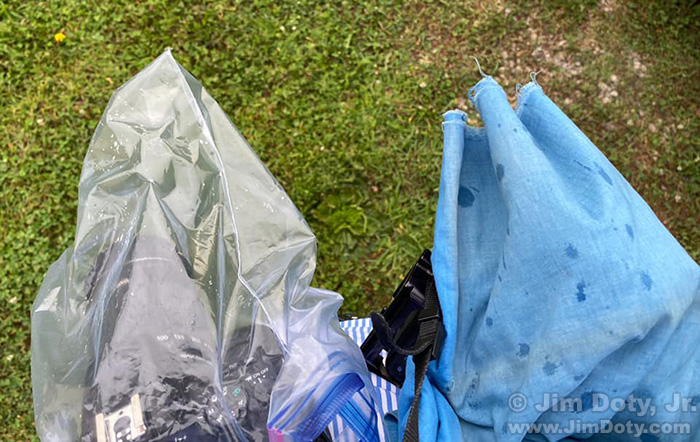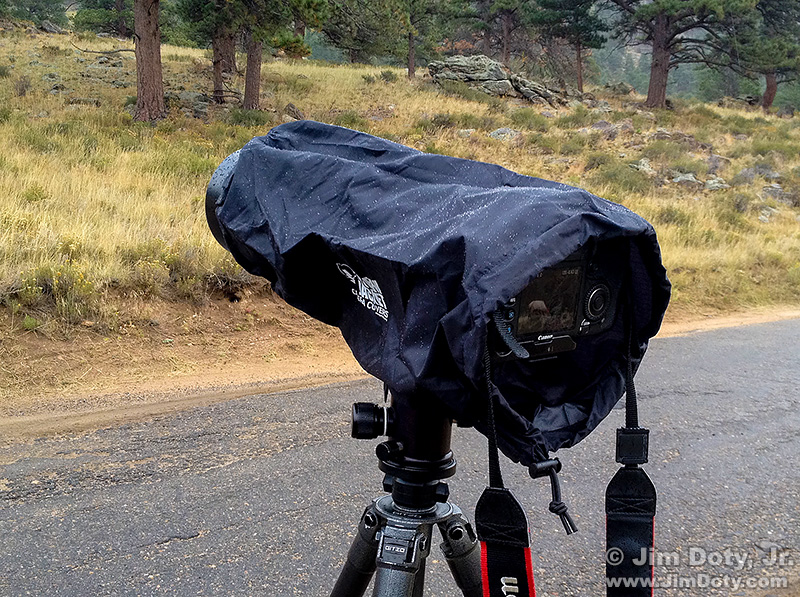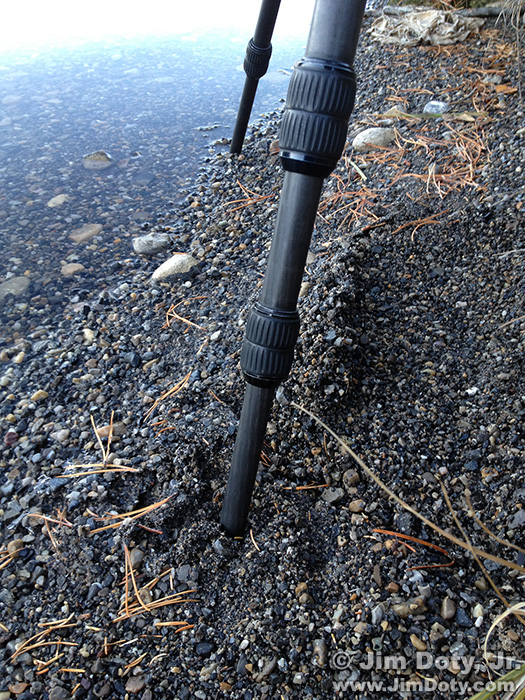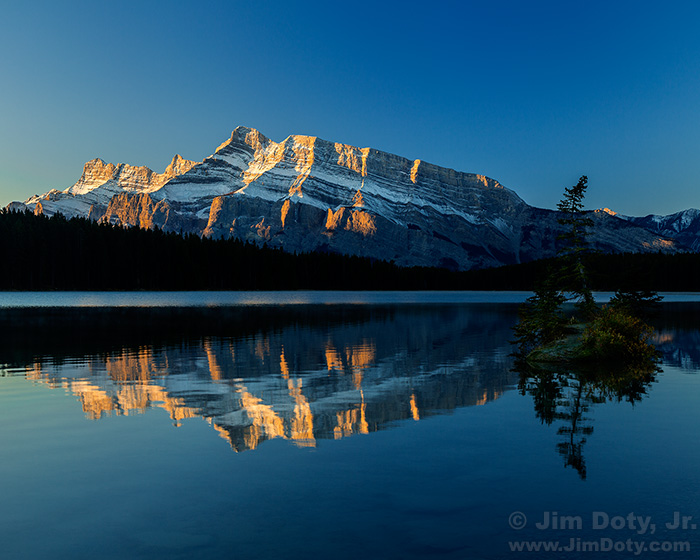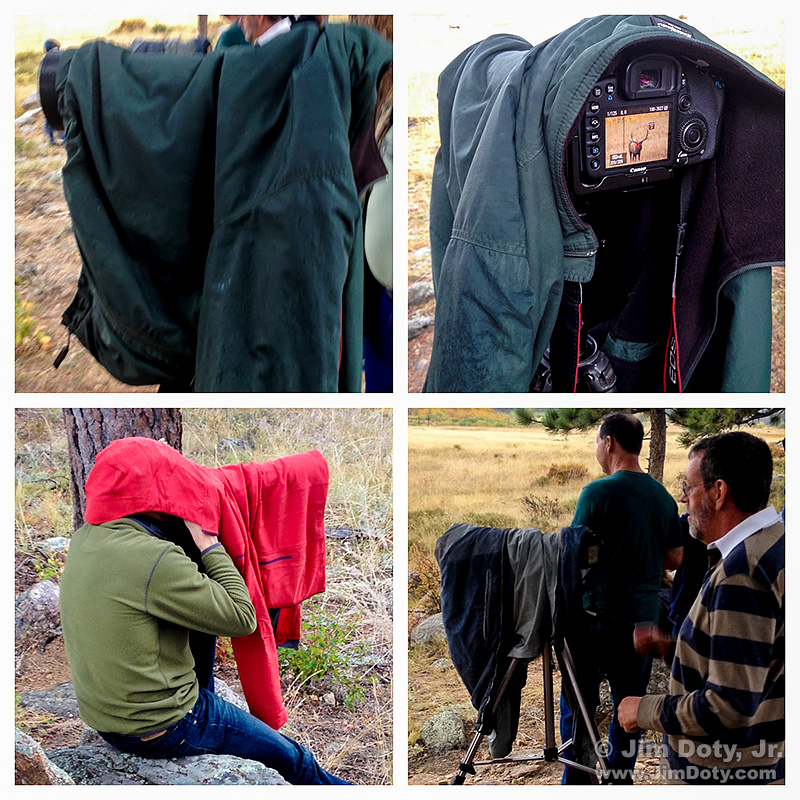
Photographers in a drizzle using coats, jackets, sweaters, hoodies, and anything else to keep their cameras and lenses dry. Rocky Mountain National Park.
Rain is not good for your camera. Some professional level cameras are “weather sealed”. So are some professional level lenses. They even have gaskets for where the lens contacts the camera. But weather sealed is not waterproof. My rule of thumb is weather sealed gear can easily handle a bit of drizzle or a light rain for a short period of time, but it will not handle a light rain for a long period of time, or a heavy downpour. A few drops of rain on weather sealed gear is ok. Much more than that and you need to protect your gear. In this article I provide you with some simple to professional suggestions to protect your gear.
Keep The Rain Off Your Camera
Moisture can seep down between the zoom and focus rings on the lens and down around the camera controls and if enough moisture gets down in there you have a problem. Over a period of time the internal metal parts will begin to rust, including the expensive circuit boards. The repair costs can run into hundred of dollars. In some cases the repair is more expansive than buying a new camera.
I was using two cameras to photograph an outdoor church service this morning and we had a little light rain. I carry a piece of cloth in my camera backpack that I drape over my camera and lens to keep the rain off. I put the blue cloth over my weather sealed camera and lens. Just about any piece of cloth will do to keep off a few rain drops.
I also carry gallon size ziplock bags in my backpack. The inexpensive camera and lens I had with me this morning are not weather sealed. They went in to a ziplock bag. You can poke a hole in a corner of a ziplock bag, stretch the hole to fit around the lens hood and shoot from inside the bag as a rain protection.
You can also use sweaters, jackets and other items of clothing to keep the rain off your gear, as the photographers are doing in the top photo. It is more important to keep your gear dry than yourself.
If rain lands on an extended zoom lens, do not contract (shorten) the zoom lens or you will drag the moisture inside the lens. Use a piece of cloth, a towel, or a paper towel to dry off the lens before you contract the lens. That is another reason I keep a piece of cloth in my camera bag, and paper towels and a bath towel in the car. A few rain drops got on the extended zoom lens barrel this morning so I used the blue cloth to dry off the lens barrel before I retracted the lens.
Storm Cover
There are professional solutions to protect your gear. If the weather is really bad, I use a Storm Jacket Camera Cover to protect my camera and lens from the rain. It is also valuable for a wet snow in the winter. The Storm Jacket is made by Vortex Media Pro. There are drawstring openings at the front and back plus an opening on the bottom for when you put your camera on a tripod. Be sure to get the right size. Put your lens on your camera and measure from the back of the camera to the front of the lens. Then check the links below for the right size.
Use Two Camera Bodies
If you have two camera bodies, use both of them to avoid changing lenses in the rain. Pick the two lenses you are most likely to use and put one lens on one body and the other lens on the other body. This morning I used a 24-105mm lens on a full frame camera body and a 55-250mm lens on the camera with a cropped sensor (smaller than 24x36mm). That gave me an effective focal length range of 24-400mm without changing lenses. See the Field of View crop article at the link below.
Tripod Joints
On a related note, you can’t keep your tripod joints out of the rain, but you should try to avoid submerging the joints in water. Rain or not, to get the composition you want you may need to stick one or more tripod legs in a river, stream, or lake. Extend the lower leg sections and put them in the water. If at all possible keeps the joints out of the water and muck. And when you get the tripod legs wet, do not collapse the legs until you dry them off. You do not want to drag moisture up into the joints and other leg sections. Some tripod joints have metal sleeves that can rust of they get wet. It can be time consuming to take the joints apart and dry off the parts. If you have to get the joints down in the water, take them apart to clean and dry them as soon as possible.
This is one of the photos I was after when two of my tripod legs were in the water.
Links
Storm Jacket Camera Covers are all available in the Misc Goodies section of my photography store with direct links to Amazon.com. You get Amazon’s great prices, service, and guarantee. Individual links follow. Make sure you follow the size recommendations at my store for the Storm Jacket Camera Covers. Individual links follow.
Storm Jacket Camera Cover – size small. For a DSLR and small lens measuring 9 inches or less from the back of the camera body to the front of the lens.
Storm Jacket Camera Cover – size medium. For a DSLR and medium lens measuring between 7 and 15 inches from the back of the camera body to the front of the lens.
Storm Jacket Camera Cover – size large. For a DSLR and long lens measuring between 14 and 23 inches from the back of the camera body to the front of the lens.
Storm Jacket Camera Cover – size extra large. For a DSLR and extra long lens measuring between 14 and 27 inches from the back of the camera body to the front of the lens.
Company Link
Vortex Media Storm Jacket Camera Covers – company web site

